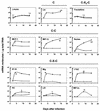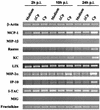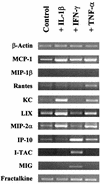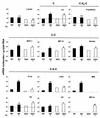Role of gamma interferon in chemokine expression in the ileum of mice and in a murine intestinal epithelial cell line after Cryptosporidium parvum infection
- PMID: 11895975
- PMCID: PMC127832
- DOI: 10.1128/IAI.70.4.2090-2099.2002
Role of gamma interferon in chemokine expression in the ileum of mice and in a murine intestinal epithelial cell line after Cryptosporidium parvum infection
Abstract
Cryptosporidium parvum is a protozoan parasite that infects intestinal epithelial cells and induces inflammation of the intestine. To better understand the inflammatory process occurring during cryptosporidiosis, we investigated in this study the kinetics of chemokine expression in the mucosa of mice by quantitative reverse transcription-PCR. Our results demonstrate that among the chemokine mRNAs studied, gamma interferon (IFN-gamma)-inducible protein 10 (IP-10), monokine induced by IFN-gamma (MIG), i-TAC, lymphotactin, macrophage inflammatory protein 1 beta (MIP-1 beta), and RANTES mRNAs were strongly up-regulated in infected neonate mice, which correlated with the immunofluorescence staining results showing T-cell and macrophage infiltration in the mucosa. Our in vitro data showed that intestinal epithelial cells infected by C. parvum or stimulated by the proinflammatory cytokines (IFN-gamma, interleukin-1 beta, and tumor necrosis factor alpha) produce a pattern of chemokine secretion similar to that observed in vivo, suggesting that these cells may take part in the initial production of chemokines. In order to identify the chemokines responsible for the recruitment of the inflammatory cells leading to a protective immune response, we compared the patterns of chemokine expression in a healing neonate mouse model and a nonhealing IFN-gamma knockout (GKO) mouse model of cryptosporidiosis. In the absence of IFN-gamma, the chemokine response was altered for IP-10, MIG, i-TAC, RANTES, and MIP-1 beta mRNAs, while the three ELR C-X-C chemokine mRNAs studied (lipopolysaccharide-induced C-X-C chemokine, MIP-2 alpha, and KC mRNAs) were strongly overexpressed. These results are consistent with the neutrophil recruitment observed in the lamina propria of GKO mice at day 9 postinfection but are not consistent with the hypothesis that these cells play an important role in the resolution of the infection. On the contrary, the altered response of chemokines responsible for the recruitment of macrophages and T cells in GKO mice suggests that these two populations may be critical in the development of a protective immune response.
Figures






Similar articles
-
Cryptosporidium parvum-specific mucosal immune response in C57BL/6 neonatal and gamma interferon-deficient mice: role of tumor necrosis factor alpha in protection.Infect Immun. 2001 Mar;69(3):1635-42. doi: 10.1128/IAI.69.3.1635-1642.2001. Infect Immun. 2001. PMID: 11179338 Free PMC article.
-
Profiles of healing and nonhealing Cryptosporidium parvum infection in C57BL/6 mice with functional B and T lymphocytes: the extent of gamma interferon modulation determines the outcome of infection.Infect Immun. 1997 Nov;65(11):4761-9. doi: 10.1128/iai.65.11.4761-4769.1997. Infect Immun. 1997. PMID: 9353062 Free PMC article.
-
Cytokine expression and specific lymphocyte proliferation in two strains of Cryptosporidium parvum-infected gamma-interferon knockout mice.J Parasitol. 2000 Apr;86(2):300-7. doi: 10.1645/0022-3395(2000)086[0300:CEASLP]2.0.CO;2. J Parasitol. 2000. PMID: 10780549
-
The role of cytokines in the pathogenesis of Cryptosporidium infection.Curr Opin Infect Dis. 2002 Jun;15(3):229-34. doi: 10.1097/00001432-200206000-00003. Curr Opin Infect Dis. 2002. PMID: 12015455 Review.
-
Innate immune responses against Cryptosporidium parvum infection.Parasite Immunol. 2013 Feb;35(2):55-64. doi: 10.1111/pim.12020. Parasite Immunol. 2013. PMID: 23173616 Review.
Cited by
-
Rabies virus-induced activation of mitogen-activated protein kinase and NF-kappaB signaling pathways regulates expression of CXC and CC chemokine ligands in microglia.J Virol. 2005 Sep;79(18):11801-12. doi: 10.1128/JVI.79.18.11801-11812.2005. J Virol. 2005. PMID: 16140757 Free PMC article.
-
Quantification of in vitro and in vivo Cryptosporidium parvum infection by using real-time PCR.Appl Environ Microbiol. 2006 Jun;72(6):4484-8. doi: 10.1128/AEM.00189-06. Appl Environ Microbiol. 2006. PMID: 16751574 Free PMC article.
-
ATP Purinergic Receptor P2X1-Dependent Suicidal NETosis Induced by Cryptosporidium parvum under Physioxia Conditions.Biology (Basel). 2022 Mar 14;11(3):442. doi: 10.3390/biology11030442. Biology (Basel). 2022. PMID: 35336816 Free PMC article.
-
Roles for NK cells and an NK cell-independent source of intestinal gamma interferon for innate immunity to Cryptosporidium parvum infection.Infect Immun. 2009 Nov;77(11):5044-9. doi: 10.1128/IAI.00377-09. Epub 2009 Aug 17. Infect Immun. 2009. PMID: 19687195 Free PMC article.
-
Bovine cryptosporidiosis: impact, host-parasite interaction and control strategies.Vet Res. 2017 Aug 11;48(1):42. doi: 10.1186/s13567-017-0447-0. Vet Res. 2017. PMID: 28800747 Free PMC article. Review.
References
-
- Adjei, A. A., J. T. Jones, and F. J. Enriquez. 2000. Differential intraepithelial lymphocyte phenotypes following Cryptosporidium parvum challenge in susceptible and resistant athymic strains of mice. Parasitol. Int. 49:119-129. - PubMed
-
- Aliberti, J. C., F. S. Machado, J. T. Souto, A. P. Campanelli, M. M. Teixeira, R. T. Gazzinelli, and J. S. Silva. 1999. β-Chemokines enhance parasite uptake and promote nitric oxide-dependent microbiostatic activity in murine inflammatory macrophages infected with Trypanosoma cruzi. Infect. Immun. 67:4819-4826. - PMC - PubMed
-
- Aliberti, J. C., J. T. Souto, A. P. Marino, J. Lannes-Vieira, M. M. Teixeira, J. Farber, R. T. Gazzinelli, and J. S. Silva. 2001. Modulation of chemokine production and inflammatory responses in interferon-gamma- and tumor necrosis factor-R1-deficient mice during Trypanosoma cruzi infection. Am. J. Pathol. 158:1433-1440. - PMC - PubMed
-
- Amichay, D., R. T. Gazzinelli, G. Karupiah, T. R. Moench, A. Sher, and J. M. Farber. 1996. Genes for chemokines MuMig and Crg-2 are induced in protozoan and viral infections in response to IFN-gamma with patterns of tissue expression that suggest nonredundant roles in vivo. J. Immunol. 157:4511-4520. - PubMed
MeSH terms
Substances
LinkOut - more resources
Full Text Sources
Medical
Research Materials

